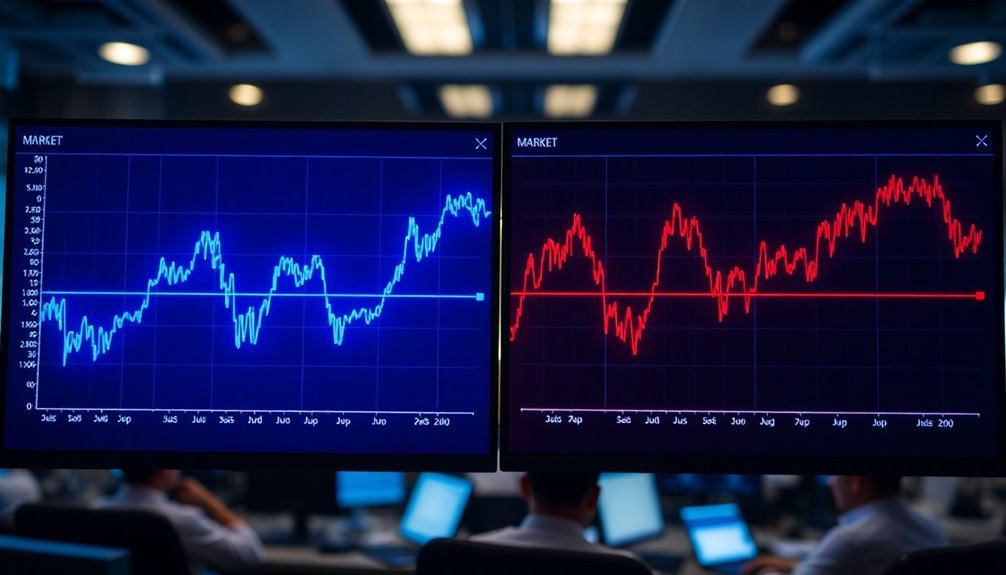Basis trading's a strategy where you buy and sell related securities to exploit price differences between cash and futures markets. You aim to profit from the gap between the spot price of an asset and its futures contract price, known as the basis. This method often takes advantage of market inefficiencies and can serve as a hedge against price fluctuations. Factors like seasonality and market sentiment can affect these price differentials. Understanding these dynamics helps you leverage opportunities more effectively. If you're curious about how to apply this in real markets, there's much more to uncover.
Key Takeaways
- Basis trading involves buying and selling related securities to exploit the difference between cash prices and futures contract prices.
- The basis is calculated as the cash price minus the futures price, reflecting market expectations and pricing inefficiencies.
- Market factors such as supply, demand, interest rates, and seasonal trends significantly influence basis differentials.
- Effective risk management strategies, including diversification and stop-loss orders, are essential to mitigate potential losses in basis trading.
- Market volatility can widen basis differentials, impacting profitability and necessitating continuous monitoring and strategic adjustments.
Key Concepts of Basis Trading

Basis trading revolves around the concept of basis, which is the difference between the cash price of an asset and its related futures contract. You can calculate the basis by subtracting the futures price from the cash price, or vice versa. Typically, this involves a futures contract and its underlying asset, or different contracts with varying expiration dates. The basis reflects market expectations and is influenced by supply, demand, and interest rates. Over time, you can expect the basis to converge as market inefficiencies get corrected. Understanding these key concepts will help you navigate the complexities of basis trading and make informed decisions in your trading strategy. Additionally, basis trading plays a crucial role in enhancing market liquidity, as it balances supply and demand while reducing price volatility.
Basis Trading Overview

In the world of finance, basis trading serves as a strategic approach to profit from price discrepancies between related financial instruments, like futures contracts and their underlying assets. This financial arbitrage strategy aims to exploit mispricing, commonly found in futures commodities markets but applicable to other instruments too, such as precious metals and interest rate products. Traders typically buy and sell similar securities across different markets, anticipating price convergence. Techniques like cash-and-carry arbitrage are often used, where the underlying asset is bought while shorting its corresponding futures contract. Effective risk management is vital, as leveraging can amplify both potential returns and risks. By capitalizing on pricing inefficiencies, basis trading enhances market liquidity and helps maintain pricing efficiency across various asset classes. Furthermore, basis trading often involves long in the spot market while being short in the futures market, allowing traders to benefit from the convergence of prices as the delivery date approaches.
Market Price Differential Analysis

Understanding market price differentials is crucial for effective trading strategies, as these differences can significantly impact your profitability.
The basis differential, the gap between the spot price and the futures price, plays a vital role in hedging commodity price exposure. This differential can be positive or negative before a futures contract expires, and it's expected to converge to zero at expiration if everything aligns perfectly. Basis differential is crucial for traders when hedging commodity price exposure, helping them identify arbitrage opportunities between spot and futures markets.
Factors like spot and futures price movements, location, and seasonal trends influence the basis. Analyzing these differentials helps you identify market conditions, liquidity, and potential vulnerabilities in your hedging strategy.
Pros and Cons Summary

While basis trading offers several advantages, such as effective risk management and profit opportunities, it also comes with its share of drawbacks.
You can reduce price volatility risks by locking in price differences, but market fluctuations can lead to unexpected losses. Basis trading requires analysis of market mispricing for execution, which can further complicate decision-making.
Although it provides potential profits from price discrepancies, you face margin and liquidity constraints that might pressure your trading positions.
Additionally, while basis trading enhances market understanding, calculation inaccuracies can mislead your trading decisions.
Lastly, although it's accessible with lower capital requirements, the exposure to physical delivery risks may complicate your trades.
Weighing these pros and cons is crucial before diving into basis trading.
Price Correlation Between Markets

Price correlations between markets play a crucial role in basis trading strategies, as they help traders identify potential opportunities for profit.
With globalization, you'll notice increasing correlations, especially between U.S. and non-U.S. stocks. Real estate investment trusts (REITs) and high-yield bonds often move in tandem with the U.S. equity market, making them relevant for your trading decisions.
Analyzing correlation coefficients can reveal how assets move together or apart, influenced by economic cycles and interest rates. During risk-on or risk-off periods, these correlations can shift, impacting your basis trading opportunities. Understanding the importance of correlation is essential for effectively managing risks in your trading strategy.
Market Volatility Impacts Profitability

Market volatility significantly affects your profitability in basis trading, as fluctuations in spot and futures prices can create both opportunities and risks.
When prices swing wildly, the basis—the difference between spot and futures prices—can widen, making trades riskier. You'll need to continuously monitor and adjust your strategies to ensure accurate basis calculations. Additionally, understanding basis risk is essential for recognizing how misalignments in related asset prices can impact your trading outcomes.
This volatility also heightens your risk, as unpredictable price movements can amplify both profits and losses, especially if you're using leverage.
Timing your entry and exit points becomes crucial; seizing temporary mispricings can boost your returns.
Analyzing market trends and diversifying across different contracts can help manage these risks, allowing you to exploit inefficiencies and enhance overall market stability.
Emerging Algorithmic Trading Strategies

Navigating the complexities of basis trading in a volatile environment can pave the way for adopting emerging algorithmic trading strategies. You can leverage predictive analytics through AI models that enhance your ability to analyze vast data quickly, adapting to market conditions dynamically. Real-time decision-making becomes crucial, utilizing sentiment analysis and global economic indicators to stay ahead. Moreover, algorithmic trading accounts for a large portion of overall trading volume, emphasizing the significance of efficient strategies. Quantum computing innovations provide unparalleled computational power, allowing you to solve complex problems and optimize trading performance. In the realm of decentralized finance, automated market makers create new opportunities while enhancing security and transparency.
Monitor Seasonal Price Patterns

Start by analyzing historical data to identify recurring fluctuations tied to specific times of the year, like the "January Effect" or "Santa Claus Rally." Use seasonal charts to visualize these trends and pinpoint entry and exit points for your trades. Additionally, consider the influence of tick-borne diseases on market conditions during certain seasons, as they can affect industries such as agriculture and tourism.
Keep in mind that factors like holidays, weather conditions, and agricultural cycles can significantly impact prices. Additionally, understanding market sentiment during specific seasons can provide deeper insights into potential price movements. Combine your findings with technical and fundamental analysis to refine your predictions.
Remember, while seasonal patterns offer valuable insights, they're not guarantees, so implement risk management plans and stay flexible to adjust your strategies as market conditions change. This approach will help you capitalize on predictable trends effectively.
Frequently Asked Questions
What Types of Assets Can Be Used in Basis Trading?
You can use a variety of assets in basis trading. Futures contracts on commodities like corn, oil, and gold are popular choices.
You can also trade underlying assets such as stocks, bonds, and ETFs. Additionally, financial instruments like options, currency contracts, and interest rate products come into play.
Don't forget about forward contracts and swaps, which can also enhance your trading strategy. Diversifying your asset types can help maximize your opportunities.
How Does Basis Trading Impact Market Liquidity?
Basis trading significantly impacts market liquidity by fostering increased trading activity between cash and futures markets.
When you engage in basis trades, you help match buyers and sellers, boosting overall trading volume. This heightened activity reduces transaction costs and enhances market functioning.
As you capitalize on price discrepancies, you contribute to a more liquid market, making it easier for participants to enter and exit positions efficiently, ultimately supporting a stable financial environment.
What Are Common Mistakes in Basis Trading?
You might think ignoring market volatility is fine, but it can lead you to unexpected losses.
Similarly, neglecting risk management principles—like setting clear entry and exit points—can leave your capital vulnerable.
Plus, inaccurate calculations can mislead your decisions, while misunderstanding basis risk can expose you to significant financial pitfalls.
Is Basis Trading Suitable for Novice Traders?
Basis trading isn't typically suitable for novice traders.
You'll find that it requires a deep understanding of market dynamics and the ability to analyze complex financial instruments. Without significant experience and capital, you might struggle with the risks involved, especially when using leverage.
Additionally, the sophisticated risk management needed can be overwhelming.
It's better to gain experience and knowledge in simpler trading strategies before diving into something as complex as basis trading.
How Do Taxes Affect Basis Trading Profits?
Taxes significantly impact your basis trading profits.
Gains or losses from these trades are subject to capital gains tax, with rates varying based on your holding period. If you hold securities for less than a year, expect to pay ordinary income rates on short-term gains.
You can offset losses against gains, reducing your taxable income. To keep everything in check, maintain accurate records and report transactions using the proper IRS forms.
Conclusion
In basis trading, you're balancing risk and reward, seizing opportunities in price differentials while navigating market volatility. You'll find that understanding seasonal patterns can sharpen your strategy, but remember, every gain comes with its share of losses. As you embrace algorithmic approaches, you're leveraging technology to enhance your edge, yet the market's unpredictability keeps you on your toes. So, whether you're a seasoned trader or just starting out, the dance between prices and profits never truly stops.









